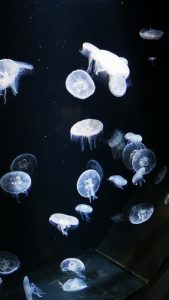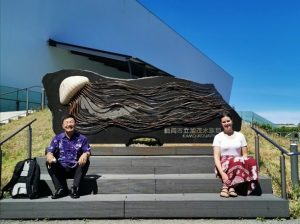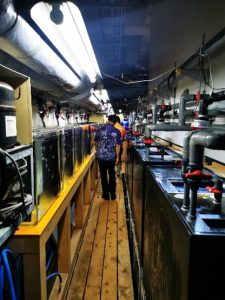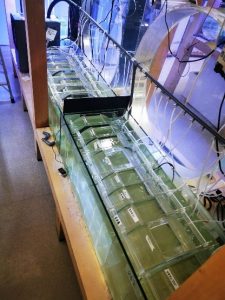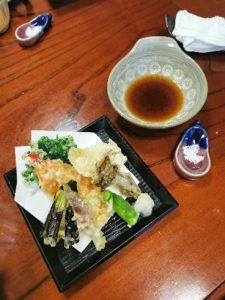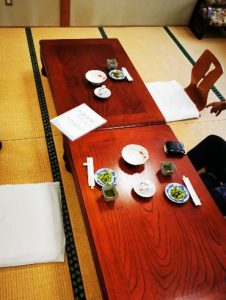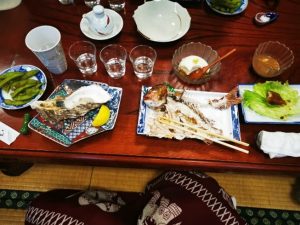Japan Week 1: Lectures & Visiting the Kamo Aquarium
2022-07-08
I officially finished my first week in Japan today and it’s been an amazing experience so far. I flew to Tokyo and spent one night to give myself enough time to change airports. I successfully navigated the complicated train system to reach my hotel and check in for the night.
[The map I was given at the train ticket counter]
When I arrived in Hiroshima the next day (Friday), my host, Professor Shin-ichi Uye, picked me up from the airport and helped me get settled into my residence at Hiroshima University. We went grocery shopping and he showed me where I could buy meals on campus, then we made plans to meet again on Monday and I spent the weekend doing some exploring.

[The view of the Hiroshima University campus from my balcony]
On Sunday, I took the bus to Hiroshima city and visited the Atomic Bomb Dome, Peace Park and the Memorial Museum.
[The cenotaph memorialising the victims of the atomic bomb, the building that was almost at the epicenter of the explosion, and the display at the entrance of the museum.]On Monday, we began jellyfish lectures. Prof. Uye’s jellyfish work is so important for Japan’s fisheries operations that the government pays his salary now that he is retired from the university so he can continue his work. I was so fortunate to receive personal lectures from Prof. Uye on the three primary species that he has researched over the last few decades. A brief synopsis of what I learned is below.
Nemopilema nomurai
This is the Nomura’s jellyfish, one of the biggest jellyfish species in the world. Individuals regularly reach 100+ kg and 2 m across. They grow from juveniles of a couple millimeters to these giant adults in about one year. They originate somewhere on the coast of China and are carried to the Sea of Japan on currents, where they often interfere with fishing operations. Years with large blooms are sporadic and as such, Prof. Uye has developed a forecasting model to predict bloom size for the season so they can warn fishers to plan for varying degrees of interference. The prediction is based on a combination of sighting surveys in waters outside of the Sea of Japan and satellite-based environmental data (temperature and wind).
[Nemopilema nomurai, Nomura’s jellyfish]
Aurelia coerulea
This is a species of moon jellyfish, similar to what we have on the coast of British Columbia but not the same species. While individual jellyfish are not as large as the giant Nomura’s jellyfish, this species occurs in high numbers and can also interfere with fishing operations. Namely, when they are caught in nets with small fish like anchovy and mackerel and sting the fish, the fish meat goes bad and cannot be sold. These jellyfish are also found closer to the shore, so they tend to clog the cooling intakes for power plants.
[Aurelia sp., moon jellyfish]
Edible Jellyfish (Rhopilema spp).
Three species of Rhopilema have been consumed for centuries in Asia, with records of processed jellyfish trade in China and Japan dating as early as 232-300 AD. Jellyfish are in especially high demand in China, so some of the Rhopilema fisheries in the Ariake Sea in Japan are owned by Chinese fishers and the catch is exported to China. To meet the demand of edible jellyfish, some companies have begun processing and eating the Nomura’s jellyfish, though the quality is not as good as Rhopilema. I will visit the Rhopilema fishery in the Ariake Sea in the coming weeks, so I will have more to say about this topic soon.
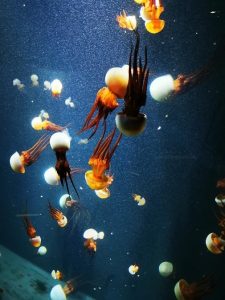
[Rhopilema esculentum, one of three species of Rhopilema commonly eaten in Japan]
On Thursday we flew to Shonai in northern Japan and bussed to Tsuruoka to visit the Kamo Aquarium. I thought it was strange when Prof. Uye said we should fly across Japan to see an aquarium given how many local aquariums there were, but now I understand why. The Kamo Aquarium originally started as a small aquarium run by local fishermen. It is located in a relatively rural area so they did not receive many visitors, and in an effort to increase their visitors they added a coral reef display. The coral must have had a jellyfish polyp on it and eventually a jellyfish emerged in the exhibit. Visitors started coming to see the jellyfish, so the owners of the aquarium decided to add some jellyfish displays. Today, the Kamo Aquarium holds the Guinness World Record for the highest number of jellyfish species on display. They had 84 different species when we visited!
[Prof. Uye and me in front of the Kamo Aquarium] [Prof. Uye, Director Okizumi, and me]
I spent most of the day taking photos and videos, but after lunch we met with the director of the aquarium since he and Prof. Uye are good friends.
We were given a tour behind the scenes and shown how they rear and care for so many species of jellyfish. I have experience working with the jellyfish at the Vancouver Aquarium so I was thoroughly impressed by how intensive and strategic their daily activities were.
[Behind the scenes at the Kamo Aquarium. They require many tanks to raise so many species]
After our tour of the Aquarium and a (not-so-brief) stop at the gift shop, we were invited to join the director and one of the aquarium staff for dinner. We ate in traditional Japanese fashion: without shoes and sitting cross-legged on the floor. We were fed an array of fresh edamame, wakame (seaweed) salad, fried bream, salted squid, fresh summer oyster, sushi, tempura, and tofu. We were given sea salt from the Sea of Japan and a sampling of four types of sake. We spent the evening talking about jellyfish and this was the perfect end to an amazing day.
[Japanese food in a traditional setting]
That’s the end of the first post. You can also follow Jessica’s science channels at @jellieswithjess.







